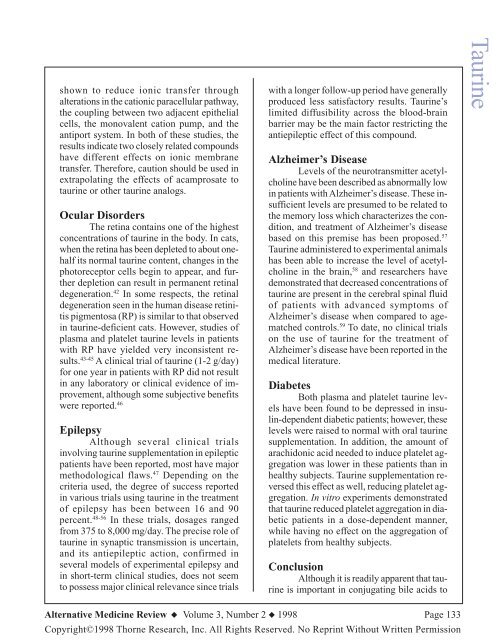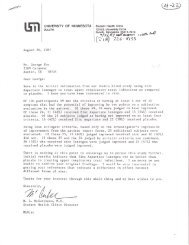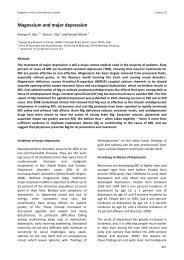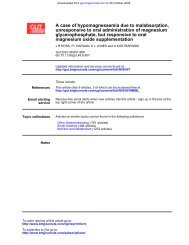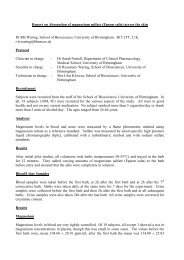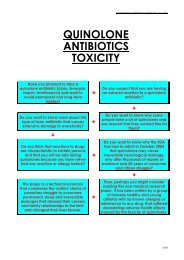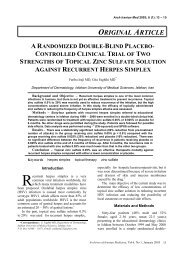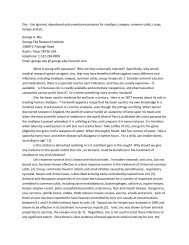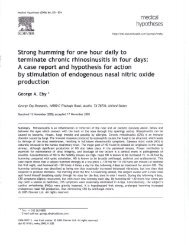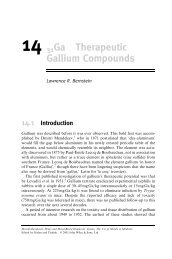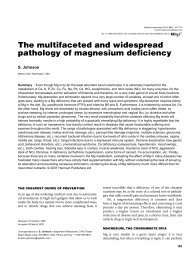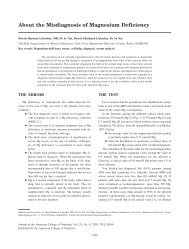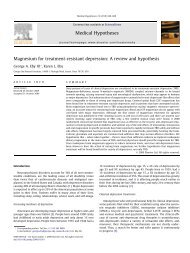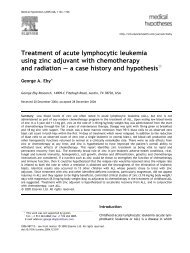Therapeutic Applications of Taurine - George Eby Research Institute
Therapeutic Applications of Taurine - George Eby Research Institute
Therapeutic Applications of Taurine - George Eby Research Institute
You also want an ePaper? Increase the reach of your titles
YUMPU automatically turns print PDFs into web optimized ePapers that Google loves.
<strong>Taurine</strong><br />
shown to reduce ionic transfer through<br />
alterations in the cationic paracellular pathway,<br />
the coupling between two adjacent epithelial<br />
cells, the monovalent cation pump, and the<br />
antiport system. In both <strong>of</strong> these studies, the<br />
results indicate two closely related compounds<br />
have different effects on ionic membrane<br />
transfer. Therefore, caution should be used in<br />
extrapolating the effects <strong>of</strong> acamprosate to<br />
taurine or other taurine analogs.<br />
Ocular Disorders<br />
The retina contains one <strong>of</strong> the highest<br />
concentrations <strong>of</strong> taurine in the body. In cats,<br />
when the retina has been depleted to about onehalf<br />
its normal taurine content, changes in the<br />
photoreceptor cells begin to appear, and further<br />
depletion can result in permanent retinal<br />
degeneration. 42 In some respects, the retinal<br />
degeneration seen in the human disease retinitis<br />
pigmentosa (RP) is similar to that observed<br />
in taurine-deficient cats. However, studies <strong>of</strong><br />
plasma and platelet taurine levels in patients<br />
with RP have yielded very inconsistent results.<br />
43-45 A clinical trial <strong>of</strong> taurine (1-2 g/day)<br />
for one year in patients with RP did not result<br />
in any laboratory or clinical evidence <strong>of</strong> improvement,<br />
although some subjective benefits<br />
were reported. 46<br />
Epilepsy<br />
Although several clinical trials<br />
involving taurine supplementation in epileptic<br />
patients have been reported, most have major<br />
methodological flaws. 47 Depending on the<br />
criteria used, the degree <strong>of</strong> success reported<br />
in various trials using taurine in the treatment<br />
<strong>of</strong> epilepsy has been between 16 and 90<br />
percent. 48-56 In these trials, dosages ranged<br />
from 375 to 8,000 mg/day. The precise role <strong>of</strong><br />
taurine in synaptic transmission is uncertain,<br />
and its antiepileptic action, confirmed in<br />
several models <strong>of</strong> experimental epilepsy and<br />
in short-term clinical studies, does not seem<br />
to possess major clinical relevance since trials<br />
with a longer follow-up period have generally<br />
produced less satisfactory results. <strong>Taurine</strong>’s<br />
limited diffusibility across the blood-brain<br />
barrier may be the main factor restricting the<br />
antiepileptic effect <strong>of</strong> this compound.<br />
Alzheimer’s Disease<br />
Levels <strong>of</strong> the neurotransmitter acetylcholine<br />
have been described as abnormally low<br />
in patients with Alzheimer’s disease. These insufficient<br />
levels are presumed to be related to<br />
the memory loss which characterizes the condition,<br />
and treatment <strong>of</strong> Alzheimer’s disease<br />
based on this premise has been proposed. 57<br />
<strong>Taurine</strong> administered to experimental animals<br />
has been able to increase the level <strong>of</strong> acetylcholine<br />
in the brain, 58 and researchers have<br />
demonstrated that decreased concentrations <strong>of</strong><br />
taurine are present in the cerebral spinal fluid<br />
<strong>of</strong> patients with advanced symptoms <strong>of</strong><br />
Alzheimer’s disease when compared to agematched<br />
controls. 59 To date, no clinical trials<br />
on the use <strong>of</strong> taurine for the treatment <strong>of</strong><br />
Alzheimer’s disease have been reported in the<br />
medical literature.<br />
Diabetes<br />
Both plasma and platelet taurine levels<br />
have been found to be depressed in insulin-dependent<br />
diabetic patients; however, these<br />
levels were raised to normal with oral taurine<br />
supplementation. In addition, the amount <strong>of</strong><br />
arachidonic acid needed to induce platelet aggregation<br />
was lower in these patients than in<br />
healthy subjects. <strong>Taurine</strong> supplementation reversed<br />
this effect as well, reducing platelet aggregation.<br />
In vitro experiments demonstrated<br />
that taurine reduced platelet aggregation in diabetic<br />
patients in a dose-dependent manner,<br />
while having no effect on the aggregation <strong>of</strong><br />
platelets from healthy subjects.<br />
Conclusion<br />
Although it is readily apparent that taurine<br />
is important in conjugating bile acids to<br />
Alternative Medicine Review ◆ Volume 3, Number 2 ◆ 1998 Page 133<br />
Copyright©1998 Thorne <strong>Research</strong>, Inc. All Rights Reserved. No Reprint Without Written Permission


